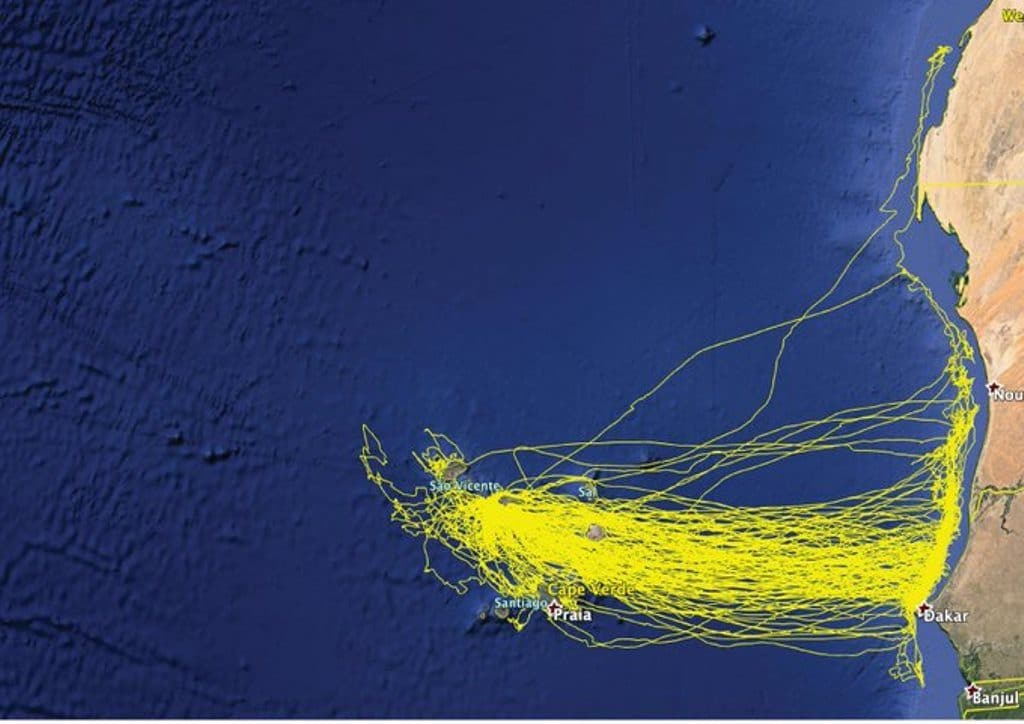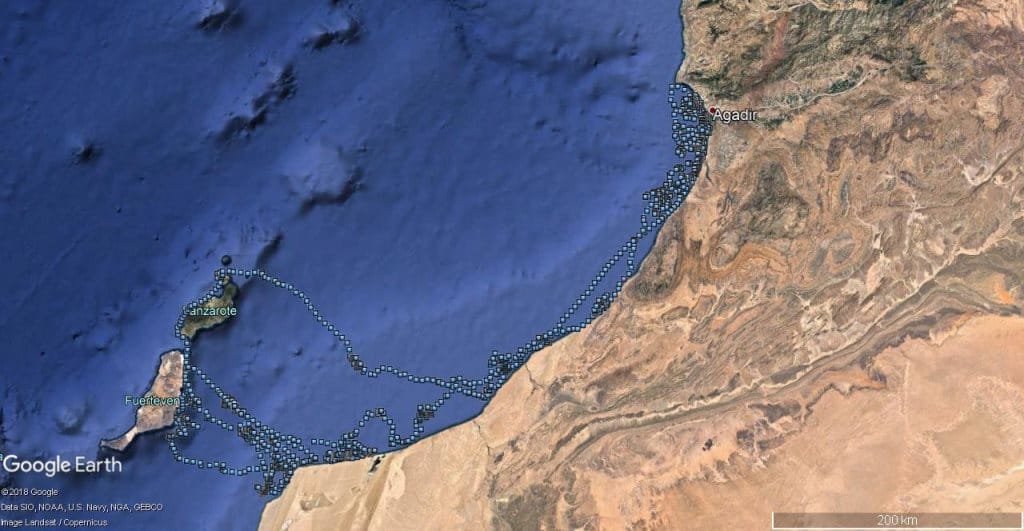The Cape Verde Shearwater (Calonectris edwardsii), as its name may suggests, is an endemic breeder to Cape Verde islands, and winters mainly in South Atlantic off South America (González-Solís et al. 2009). The species rarely ventures north of its breeding areas (or so we thought!).
During the breading season, Cape Verde Shearwaters also frequently visit the rich upwelling area off the West African coast between Senegal and northern Mauritania (Paiva et al. 2015). Although occasional feeding trips to Cap Nouadhibou (Cap Banc) and as far north as Dakhla were also recorded thanks to GPS tracking (map below), sightings of Cape Verde Shearwaters north of their home range (breeding and feeding areas) are still relatively rare.

Sightings of Cape Verde Shearwaters north of their normal range
North of Cap Nouadhibou in Mauritania, there are only a handful of records from the Canary Islands, Selvagens Islands and Morocco.
Selvagens Islands: the first record for these islands was a dead bird in June 2005. The second one was a live bird resting in the middle of a Cory’s Shearwater (Calonectris borealis) colony (see Fagundes et al. 2012).
Canary Islands: the first records for the archipelago were found at a Cory’s Shearwater colony at Montaña Clara islet, north of Lanzarote: two different adults of undetermined sex caught during ringing sessions on 6 and 23 May 2010 respectively (see Gutiérrez et al. 2010). The third record for the Canaries was also caught and ringed at that same Cory’s Shearwater colony in summer 2013 (Jacob González-Solís & Laura Zango 2013).
Three additional records were obtained in summer 2016 (see Gil-Velasco et al. 2016): three different birds were caught and ringed at three different Cory’s Shearwater colonies in the archipelago: one at Barranco de Veneguera (Gran Canaria), one at Montaña Clara islet (off Lanzarote) and one at Timanfaya National Park (Lanzarote).
Morocco: two birds at Souss estuary on 19 March 2001. This record was not accepted at the time, but after fresh documentation become available it was re-analysed and accepted three years later (Bergier et al. 2009). This was the first Moroccan record for the species.

GPS tracking of a Cape Verde Shearwater caught in the Canary Islands
During the breeding season of 2019, yet another Cape Verde Shearwater was trapped in the Cory’s Shearwater colony at Montaña Clara islet by the University of Barcelona’s ‘Seabird Ecology’ group. “[The bird] has a brood patch typical of breeders (but also some pre-breeders), and it went into an inaccessible burrow when released”, wrote the group on Twitter (embedded below). The bird was fitted with a GPS tracking device to follow its movement.
In Montaña Clara (#Lanzarote, #Canary Is) we found again a Cape Verde #shearwater! #Calonectris edwardsii, buuuuuut this bird seems to breed! It has a brood patch typical from breeders (but also some pre-breeders) & it went into an inaccessible burrow when released📸Mariona Sardà pic.twitter.com/vyuHizT08H
— Seabird Ecology Lab (@SeabirdEcology) July 9, 2019
Less than a month later, the GPS tracking got interesting results (map below): the bird visited the Moroccan coast and went up north to Agadir and Cap Ghir (this area is known for seawatching as it attracts good numbers of seabirds relatively close to shore).

The birds whose movements are shown in the two maps would be the second and the third known records for the species in Morocco.
Taken together, all these records and new data show that Cape Verde Shearwaters do wander north of their normal range albeit probably in very small numbers.
References:
Bergier, P., Franchimont, J., Thévenot, M. & the MRBC. 2009. Rare birds in Morocco: report of the Moroccan Rare Birds Committee (2004–2006). Bull ABC 16: 23-26.
Fagundes, I., Pérez, C. & Moniz, F. 2012. Cape Verde Shearwater in Selvagens in April 2012. Dutch Birding 34: 310-311.
Gil-Velasco, M., Rouco, M., Ferrer, J., García-Tarrasón, M., García-Vargas, F. J., Gutiérrez, A., Hevia, R., López, F., López-Velasco, D., Ollé, À., Rodríguez, G. Sagardía, J. & Salazar, J. A. 2018. Observaciones de aves raras en España, 2016. Ardeola 65: 97–139.
González-Solís, J., Felicísimo, A., Fox, J.W., Afanasyev, V., Kolbeinsson, Y. & Muñoz, J. 2009. Influence of sea surface winds on shearwater migration detours. Marine Ecology Progress Series 391: 221-230.
Gutiérrez, R., Lorenzo, J.A., Gorospe, G., Gutiérrez, P., López-Velasco, D., Martí-Aledo, J., Sales, S. & Vidal, C. 2011. Observaciones de aves raras en España, 2010. Ardeola 59: 353-411.
Paiva, V.H., Geraldes, P., Rodrigues, I., Melo, T., Melo, J. & Ramos, J.A. 2015. The foraging ecology of the endangered Cape Verde Shearwater, a sentinel species for marine conservation off West Africa. PloS One 10(10): e0139390.
I’m staying in Los Gigantes, Tenerife, each night around 9:45 I start herding the sounds of returning shearwaters, same time every night. Is this possible?
I did not know these birds occupy the Canary Islands
Please advise
Derek